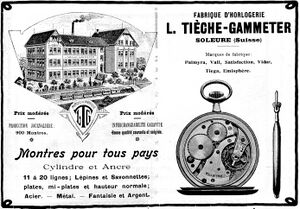Lucien Tièche: Difference between revisions
| (6 intermediate revisions by the same user not shown) | |||
| Line 1: | Line 1: | ||
[[File:RIH 1915 18-019 LTG.png|right|200px]] | [[File:RIH 1915 18-019 LTG.png|right|200px]] | ||
Lucien Tièche ( | Lucien Tièche ([[1856]]-[[1926]]) was a businessman who took over the [[Langendorf Watch Company]] following the death of [[Charles Kottmann]] in [[1890]], facing the ire of striking workers in the 1890s. Tièche formed his own firm in [[1903]], registering the [[Roamer]] brand in [[1908]]. It was taken over by [[Meyer & Stüdeli]] in [[1916]], who made this brand famous in the 20th century. | ||
Alfred Lucien Tièche | ==Early Life== | ||
Alfred Lucien Tièche was born in [[1856]] in [[Reconvilier]]. He was noted as a shopkeeper in records. He was likely related to the Tièche family of watchmakers in the town, including ebauche maker [[Kuhn & Tièche]]. | |||
==Langendorf Watch Company== | ==Langendorf Watch Company== | ||
| Line 8: | Line 10: | ||
Lucien Tièche came to Langendorf in [[1881]] to work in [[Lanco|the watch factory there]]. Arriving on April 4, he swiftly rose to become a close associate of [[Charles Kottmann]] and joined the management committee of the factory by [[1887]] and was named technical director. | Lucien Tièche came to Langendorf in [[1881]] to work in [[Lanco|the watch factory there]]. Arriving on April 4, he swiftly rose to become a close associate of [[Charles Kottmann]] and joined the management committee of the factory by [[1887]] and was named technical director. | ||
Charles Kottmann died suddenly on January 16, [[1890]]. The board of directors promoted Tièche to manage the business | Charles Kottmann died suddenly on January 16, [[1890]]. The board of directors promoted Tièche to manage the business four days later and is officially made a director on February 14. He continued to mechanize production to increase productivity. Watch movements were produced on a moving assembly line, and an in-house dial and case making capability was soon added. | ||
Attempting to navigate the crisis caused by over-production of ebauches, Langendorf worked with the other factories to establish the [[Comptoir Général des Ébauches]] in [[1892]]. But Tièche ultimately refused to join, once it became clear that the [[Fabrique d'Horlogerie de Fontainemelon]] did not see the agreement as binding. Thus, Lucien Tièche and [[Auguste Robert]] of FHF were widely seen as "killing" the creation of this organization. | |||
Tièche was not loved or respected by the workers, especially after he took a hard line against them during the general strikes of [[1894]]. He was called a "carpetbagger" and accused of mistreating workers in the (predominately socialist) newspapers. He responded to the demands of workers who had walked out by threatening to fire the rest of the unionized workers. It was reported the following year that [[Euseb Obrecht-Kessler]] of the [[Société d'Horlogerie de Granges]], [[Peter Obrecht]] of [[Obrecht & Cie]], and [[Adolf Schild-Hugi]] of [[Eterna|Gebr. Schild & Co.]] were allowing Tièche to bear the brunt of the negotiations that they would later benefit from. | Tièche was not loved or respected by the workers, especially after he took a hard line against them during the general strikes of [[1894]]. He was called a "carpetbagger" and accused of mistreating workers in the (predominately socialist) newspapers. He responded to the demands of workers who had walked out by threatening to fire the rest of the unionized workers. It was reported the following year that [[Euseb Obrecht-Kessler]] of the [[Société d'Horlogerie de Granges]], [[Peter Obrecht]] of [[Obrecht & Cie]], and [[Adolf Schild-Hugi]] of [[Eterna|Gebr. Schild & Co.]] were allowing Tièche to bear the brunt of the negotiations that they would later benefit from. | ||
| Line 19: | Line 23: | ||
Following the arrival of [[Ernst Kottmann|Ernst]] and [[Rudolf Kottmann]] in [[1901]], Tièche left the firm to start his own watch handling business. Known as L. Tièche-Gammeter, it was founded on January 7, [[1903]] in Solothurn and continued to bear the brunt of worker animosity. The company was taken over in [[1916]] by [[Meyer & Stüdeli]], which was founded by former Langendorf factory workers. The most lasting contribution of Tièche is the [[Roamer]] brand, which he registered in 1908 and would continue through the 20th century. | Following the arrival of [[Ernst Kottmann|Ernst]] and [[Rudolf Kottmann]] in [[1901]], Tièche left the firm to start his own watch handling business. Known as L. Tièche-Gammeter, it was founded on January 7, [[1903]] in Solothurn and continued to bear the brunt of worker animosity. The company was taken over in [[1916]] by [[Meyer & Stüdeli]], which was founded by former Langendorf factory workers. The most lasting contribution of Tièche is the [[Roamer]] brand, which he registered in 1908 and would continue through the 20th century. | ||
Lucien Tièche died on December 4, [[1926]] in [[Bern]]. He was survived by his widow Elise (née Gammeter) and daughter | ==Later Life== | ||
Lucien Tièche died on December 4, [[1926]] in [[Bern]]. He was survived by his widow Elise (née Gammeter) and daughter Berthe Tièche. They operated a grocery shop named Tièche-Gammeter specializing in fine foods in Bern through Elise's death in 1944. | |||
[[Category:Biography T|Tièche, Lucien]] | [[Category:Biography T|Tièche, Lucien]] | ||
Latest revision as of 17:52, 8 July 2024

Lucien Tièche (1856-1926) was a businessman who took over the Langendorf Watch Company following the death of Charles Kottmann in 1890, facing the ire of striking workers in the 1890s. Tièche formed his own firm in 1903, registering the Roamer brand in 1908. It was taken over by Meyer & Stüdeli in 1916, who made this brand famous in the 20th century.
Early Life
Alfred Lucien Tièche was born in 1856 in Reconvilier. He was noted as a shopkeeper in records. He was likely related to the Tièche family of watchmakers in the town, including ebauche maker Kuhn & Tièche.
Langendorf Watch Company
- See Also: Langendorf Watch Company
Lucien Tièche came to Langendorf in 1881 to work in the watch factory there. Arriving on April 4, he swiftly rose to become a close associate of Charles Kottmann and joined the management committee of the factory by 1887 and was named technical director.
Charles Kottmann died suddenly on January 16, 1890. The board of directors promoted Tièche to manage the business four days later and is officially made a director on February 14. He continued to mechanize production to increase productivity. Watch movements were produced on a moving assembly line, and an in-house dial and case making capability was soon added.
Attempting to navigate the crisis caused by over-production of ebauches, Langendorf worked with the other factories to establish the Comptoir Général des Ébauches in 1892. But Tièche ultimately refused to join, once it became clear that the Fabrique d'Horlogerie de Fontainemelon did not see the agreement as binding. Thus, Lucien Tièche and Auguste Robert of FHF were widely seen as "killing" the creation of this organization.
Tièche was not loved or respected by the workers, especially after he took a hard line against them during the general strikes of 1894. He was called a "carpetbagger" and accused of mistreating workers in the (predominately socialist) newspapers. He responded to the demands of workers who had walked out by threatening to fire the rest of the unionized workers. It was reported the following year that Euseb Obrecht-Kessler of the Société d'Horlogerie de Granges, Peter Obrecht of Obrecht & Cie, and Adolf Schild-Hugi of Gebr. Schild & Co. were allowing Tièche to bear the brunt of the negotiations that they would later benefit from.
The strike was ultimately resolved, with Tièche remaining in charge of the Langendorf factory, but the damage to his reputation was severe. The call went up to bring the Kottmann family back to manage the factory, and the sons of Dr. Auguste Kottmann, younger brother of Charles Kottmann, were the ideal successors.
L. Tièche-Gammeter

- See Also: Roamer
Following the arrival of Ernst and Rudolf Kottmann in 1901, Tièche left the firm to start his own watch handling business. Known as L. Tièche-Gammeter, it was founded on January 7, 1903 in Solothurn and continued to bear the brunt of worker animosity. The company was taken over in 1916 by Meyer & Stüdeli, which was founded by former Langendorf factory workers. The most lasting contribution of Tièche is the Roamer brand, which he registered in 1908 and would continue through the 20th century.
Later Life
Lucien Tièche died on December 4, 1926 in Bern. He was survived by his widow Elise (née Gammeter) and daughter Berthe Tièche. They operated a grocery shop named Tièche-Gammeter specializing in fine foods in Bern through Elise's death in 1944.